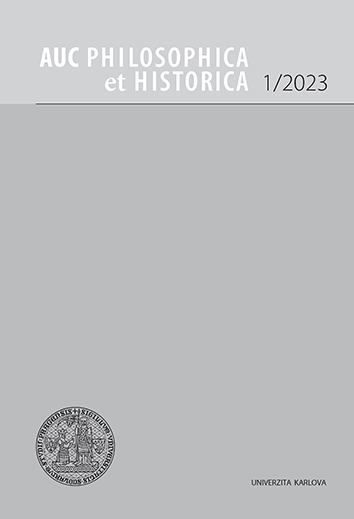AUC Philosophica et Historica (Acta Universitatis Carolinae Philosophica et Historica) is a multidisciplinary academic journal focused on the humanities with more than 50 years of tradition.
The journal is indexed in CEEOL, DOAJ, and EBSCO.
AUC PHILOSOPHICA ET HISTORICA, Vol 2019 No 2 (2019), 255–262
Třetí oko historika/historičky umění
[The Third Eye of an Art Historian]
Eva Skopalová
DOI: https://doi.org/10.14712/24647055.2020.19
published online: 14. 09. 2020
abstract
The third eye of an art historian is the issue of intuition as a tool for the anachronistic methodology of art history. In this paper, by calling the anachronistic perspective on art history a method, I would like to point to the original meaning of the word method as a way. The perception of art is an event of looking, the sight of the work of art is also insight. This is only possible via intuition, which comes from the Latin tueri, or “looking into”. Gottfried Wilhelm Leibniz considered intuitive knowledge as the most appropriate form of cognition, because it is cognition a priori. I have analyzed the methodological approach to history by Georges Didi-Huberman and intuition seems to be the key. I have also distinguished its use in the works of Alexander Nagel and Christopher S. Wood. However, they rationalized this highly creative tool; we can conclude that their use of intuition makes an anachronistic method of the anachronistic perspective, supporting the creativity of the art historian. The method is one by which we make various insights to decentralize the hyper structure of history with unpredictable interpretations that differ each time we look inside.
keywords: third eye; intuition; Gottfried Wilhelm Leibniz; anachronism; methodology of art history
references (15)
1. Milena Bartlová, Poznámky k "dějinám umění", in Opuscula historiae atrium XLVI, 2002, s. 103-110.
2. René Descartes, Discours de la méthode, Paris 1991.
3. Michela Fišerová, Obraz a moc: Rozhovory s francouzskými mysliteli, Praha 2015.
4. Alena Janatková, Reflexe a pojetí baroka v moderně, in: Olga Fejtová et al. (edd.), Barokní Praha - Barokní Čechie, 1620-1740, Praha 2004, s. 1025-1052.
5. Carl Gustav Jung, Psychologie du yoga de la kundalinî, Paris 2005.
6. Gottfried Wilhelm Leibniz, Nové úvahy o lidské soudnosti, Praha 1932.
7. James Mallinson - Mark Singleton (edd.), Roots of Yoga, London 2017.
8. Jiřina Stachová (ed.), Intuice ve vědě a filosofii, Praha 1993.
9. Alexander Nagel - Christopher S. Wood, Anachronic Renaissance, New York 2010. CrossRef
10. Alexander Nagel, Medieval Modern, New York 2012.
11. Zdeněk Neubauer, Vzhled a vhled: K ontologickým předpokladům intuice, in: Jiřina Stachová (ed.), Intuice ve vědě a filosofii, Praha 1993, s. 34-42.
12. Marine Picon, What Is the Foundation of Knowledge? Leibniz and the Amphibology of Intuition, in: Marcelo Dascal (ed.), Leibniz: What Kind of Rationalist?, Jerusalem 2008, s. 213-227. CrossRef
13. Alois Riegl, Die Entstehung des Barockkunst in Rom, Wien 1908.
14. Christopher S. Wood (ed.), Vienna School Reader: Politics and Art Historical Method in the 1930s, New York 2000.
15. Dork Zabunyan (ed.), Georges Didi-Huberman, Paris 2012.

Třetí oko historika/historičky umění is licensed under a Creative Commons Attribution 4.0 International License.
